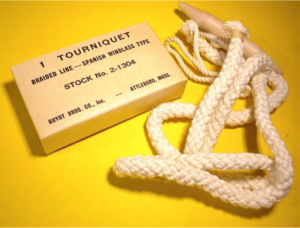
Massive Hemorrhage and Klingons
- Posted by Mike Shertz MD/18D
- Categories (M) Massive Hemorrhage
🕖 Reading Time, 9 minutes
A friend I have known since junior high and I were recently discussing tourniquets and hemorrhage control. While not an unusual discussion topic among my friends, Robert Meyer Burnett does not work in EMS or emergency medicine. Nor is he in anyway related to Special Operations or the military. Robert has spent his entire life working in the film industry in Hollywood.
Robert asked a simple question: Do tourniquets work on Klingons? While this might seem a ridiculous question about whether life-saving devices would work for hemorrhage control on imaginary creatures like Klingons from the Star Trek universe, Robert takes his Star Trek very seriously.

Robert has been a lifelong Star Trek aficionado for the over thirty-five years I have known him.
Among his other work, Robert spent several years writing, editing, and producing more than 50 hours of original content for the HD restoration of both Star Trek: The Next Generation and Star Trek: Enterprise. He has won awards for his work on these projects. Additionally, he made a cult film starring William Shatner, called “Free Enterprise,” currently streaming on Amazon. Needless to say, he was intolerant to anything less than a studious consideration of his question.
Although Klingons have redundant and supernumerary organs like an extra set of kidneys, a third lung, and even the ability to literally grow a spine, none of those extra organs or abilities will help them heal if they bleed out from an extremity wound.
As Arnold Schwarzenegger said in Predator – “If it bleeds we can kill it”. Unfortunately, that also means if you bleed, you could die.
So the Question is: Do Tourniquets Work on Klingons?
A tourniquet is a constricting device placed all the way around a limb and tightened to eliminate arterial blood flow past the device. Although most have been told that placement of a tourniquet is “the last resort” technique to eliminate bleeding from a limb wound. Prior dogma directs to use them only after direct pressure, a bandage, and a pressure dressing has failed, but in the meantime, there have been over 10,000 tourniquet applications during the recent wars in Afghanistan and Iraq, with over 2,000 lives saved.
Tourniquets are not the last resort.
US and coalition military forces routinely place tourniquets on wounded extremities as the first attempt at hemorrhage control. This is so even if it is not immediately apparent the bleeding is life-threatening.
In all recorded modern combat dating from 1701 until US involvement in Afghanistan in 2001, the rate of soldiers killed in combat to wounded was always 1 to 4. Neither ambulance evacuation from combat, antibiotics, nor advancements in surgical technique improved that survival rate. That is because 80 to 90% of those who die in combat die before they reach a hospital or surgeon. Potentially, like the Klingon with massive bleeding from a seemingly trivial limb wound.
Specifically, ten percent of US casualties in WWII, Korea, and Vietnam died from isolated wounds to their extremities. Something a proper tourniquet might have prevented. Since the advent of what the military calls “Tactical Combat Casualty Care guidelines,” this ratio of KIA to WIA reached an all-time low of 1 killed to 10 wounded. That is in spite of the huge burden of IED injuries, which in general lead to more extensive physical damage than gunshot wounds.
Specialized tourniquets are routinely placed during surgery to keep bleeding out of the surgical field so surgeons can see what they are operating on. These tourniquets are generally safe even if they are tight for up to two hours.
The myth of tourniquets as “last resort” devices stemmed from WWII where none of the  issued tourniquets worked well to eliminate arterial flow past the device. Besides allowing the casualty to die if they had massive hemorrhage, this flaw frequently caused such significant limb damage that amputation became necessary. At the completion of that war, the standard dogma of placing a tourniquet equals amputation was firmly entrenched.
issued tourniquets worked well to eliminate arterial flow past the device. Besides allowing the casualty to die if they had massive hemorrhage, this flaw frequently caused such significant limb damage that amputation became necessary. At the completion of that war, the standard dogma of placing a tourniquet equals amputation was firmly entrenched.
Newer devices used by the Department of Defense have been researched and studied over the past 15 years of combat during the Global War on Terror.
Despite over 10,000 applications, there has been only one amputation caused by an issued tourniquet. It was left on an American casualty for 8 hours while transported from one side of Africa to the other.
Turning back to our Klingon friend, perhaps the most significant issue regarding tourniquet use on Klingons is their physical size. Current US Department of Defense tourniquets are sized to fit the 99 percentile or largest of American service members. When tourniquets fail, it is usually on larger limbs.
In the end, although tourniquets generally work for hemorrhage control on any extremity they can adequately circumferentially tighten around, Klingons are too large for current Earthly tourniquets. They will need to manufacture their own devices to account for their larger sized extremities. However, your more average sized humanoid limbs will fit commercial tourniquets just fine.
So in answer to Robert’s question, yes tourniquets will work on Klingons.
Why is any of this relevant to you? In October 2015 the Earth US White House released a “Stop the Bleed” campaign to encourage every citizen to learn proper hemorrhage control of bleeding wounds. The White House wants to “…encourage bystanders to become trained, equipped, and empowered to help in a bleeding emergency before professional help arrives.” https://www.dhs.gov/stopthebleed
If you would like to learn more about these topics visit https://www.c-tecc.org, which is an organization translating military lessons learned regarding care of wounded soldiers into the management of the civilian injured.
However, if you’d like kick-ass training on these topics taught by a ruggedly handsome former Spec Ops guy, click the link below to get started.
If you just need to geek out on Star Trek, Robert can be reached easily and often through social media.
Dr. Mike Shertz is the Owner and Lead Instructor at Crisis Medicine. Dr. Shertz is a dual-boarded Emergency Medicine and EMS physician, having spent over 30 years gaining the experience and insight to create and provide his comprehensive, science-informed, training to better prepare everyday citizens, law enforcement, EMS, and the military to manage casualties and wounded in high-risk environments. Drawing on his prior experience as an Army Special Forces medic (18D), two decades as an armed, embedded tactical medic on a regional SWAT team, and as a Fire Service and EMS medical director.
Using a combination of current and historical events, Dr. Shertz’s lectures include relevant, illustrative photos, as well as hands-on demonstrations to demystify the how, why, when to use each emergency medical procedure you need to become a Force Multiplier for Good.



